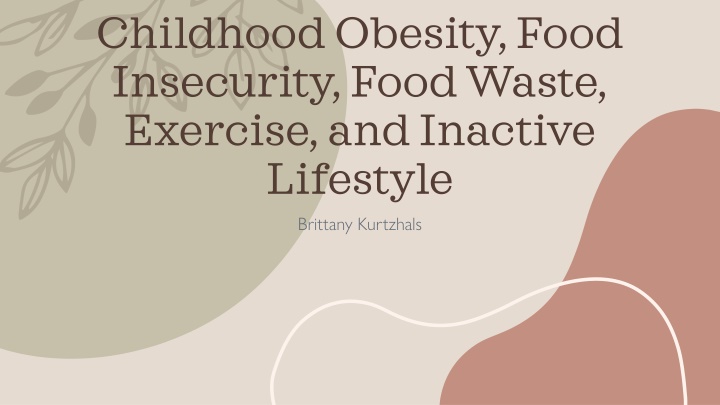
Childhood Obesity, Food Insecurity, and Inactive Lifestyle
Explore the challenges of childhood obesity, food insecurity, food waste, exercise, and inactive lifestyle. Learn about the impact on children's health and well-being, with insights on global trends, causes, and solutions to improve overall lifestyle choices.
Download Presentation

Please find below an Image/Link to download the presentation.
The content on the website is provided AS IS for your information and personal use only. It may not be sold, licensed, or shared on other websites without obtaining consent from the author. If you encounter any issues during the download, it is possible that the publisher has removed the file from their server.
You are allowed to download the files provided on this website for personal or commercial use, subject to the condition that they are used lawfully. All files are the property of their respective owners.
The content on the website is provided AS IS for your information and personal use only. It may not be sold, licensed, or shared on other websites without obtaining consent from the author.
E N D
Presentation Transcript
Childhood Obesity, Food Insecurity, Food Waste, Exercise, and Inactive Lifestyle Brittany Kurtzhals
About Me Student at UW Stout getting Bachelors Degree in Human Development and Family Studies volunteering with Craig Clifton Inc 20XX presentation title 2
Food Waste Nearly one-third of any food produced throughout the world goes uneaten. Grocery stores, restaurants, and consumers are the biggest reason why there is so much food waste. This is due to: Being encouraged to buy more than is needed, too many products being made that aren t being sold, too large of portions being sold in restaurants Example: People deciding to abandon food in the grocery store they intend to buy, tends to go to waste. As well as if food is returned by consumer Bad weather (People buy more than they may need in anticipation for bad weather). It s a combination of carelessness and ignorance for why people might waste food. They don t realize/think about what might happen to the food if they don t want it anymore. Food waste is least common in South/South-East Asia because they eat their food and throw a lot less of it away. 20XX presentation title 3
Exercise Do you live near parks or sidewalks to walk on? A lack of physical areas and afterschool activities to exercise or play at can also impact an inactive lifestyle. Over usage of television phones, and computers can impact it as well Does your school have many afterschool activities or sports to join? 10.2 million children participate in afterschool programs each year 20XX presentation title 4
Inactive Lifestyle The least active states in the US that exercise 30% less regularly are: Alabama Mississippi Arkansas The healthiest state in the US is Colorado Saudi Arabia is the least active country 20XX presentation title 5
Food Insecurity The most common cause of food insecurity in children is poverty. They might not have access to enough money to be able to afford good quality food They might not have access to good quality food. In some areas the closest place may be a gas station or fast-food restaurant. 20XX presentation title 6
Childhood Obesity The country with the highest child obesity rate is China at 61 million people. The United States is the third highest country at over 16 million people Colorado is the state with the lowest child obesity rate because it is the state where people tend to have the most active lifestyles. 20XX presentation title 7
Awareness Talking with your family about food usage/ donating extra food to a local food bank or homeless shelter Find ways to advocate for less food waste in your school Start a club or group participating in different sports or physical to encourage more exercise 20XX presentation title 8
Works Cited Quinton, A. (2022, September 30). Why is one-third of our food wasted worldwide? UC Davis. Retrieved February 28, 2023, from https://www.ucdavis.edu/food/news/why-is-one-third-of-food-wasted- worldwide CDC. (2022, May 17). Childhood obesity facts. Centers for Disease Control and Prevention. Retrieved February 28, 2023, from https://www.cdc.gov/obesity/data/childhood.html https://health.gov/healthypeople/priority-areas/social-determinants- health/literature-summaries/food-insecurity 20XX presentation title 9




